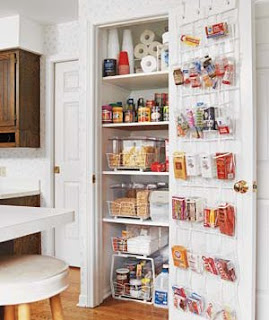 When you know the price ranges for your common items, you will be able to spot when they hit their lowest price. When they hit their lowest point, you should stock up and buy at least four to six weeks’ worth of that item. By taking this approach, you’ll be stocking up (at their lowest price) on a few items every week. By the time you have gone through your supply of any particular item, you’ll likely find that it is at its lowest price again.
When you know the price ranges for your common items, you will be able to spot when they hit their lowest price. When they hit their lowest point, you should stock up and buy at least four to six weeks’ worth of that item. By taking this approach, you’ll be stocking up (at their lowest price) on a few items every week. By the time you have gone through your supply of any particular item, you’ll likely find that it is at its lowest price again.
“The key to really saving money is to buy items when they are at their lowest price, not necessarily when you run out of the item. By taking this “stocking up” approach, you will be saving an average of 50-70% off of these items.” (source: Stephanie Nelson’s “Cut Your Grocery Bill in Half”)
Some organizational tips for organizing your stockpile area:
1. Find a place for dry items. You will need to find an area in your house for your stockpile. Is your kitchen small but you never use the hall closet? Make it into a pantry. Can your washer and dryer be moved to the basement so that you can turn that room/closet into a pantry? Are there other rooms in the house that can be used to store non-food items like toilet paper and body wash? Be creative.
2. Find a place for frozen items. In addition to dry goods, you should also be stocking up on items that can be kept frozen till use (including cheese, bread, chips, meat, frozen meals, frozen veggies, etc.). Even if you don’t own a deep freeze, you can still stockpile frozen goods. Dedicate a space in your refrigerator’s freezer that is for stockpiling.
3. Clean up. Remove expired items from your pantry. And while you are at it, donate items in your kitchen that you never use. Clear things out and make room for your new stockpile and items you do use.
4. Be mindful of expiration dates. When you are shopping try to pick the item with the longest expiration date. When your items are at home, always put the items with the shortest expiration date to the front. Every month, go through your stockpile and pull out items that will expire before you have a chance to use them and donate them to a local food pantry. You know the items will be used and it feels good to share your wealth.
5. Place like items together. This way you’ll know when to buy again. If half your body wash is stored in an upstairs bathroom and half is stored in the hall closet – you’ll never know how many bottles you have or if you should restock. Also, put detergents and cleaners on a different shelf than food items.
6. Be mindful of items that don’t move. I was super excited to get Pop-Tarts for $.25 a box last summer. Until I realized that in January, we had just as many boxes of Pop-Tarts as we did in August. So they all got donated and I made a mental note that no one in my family likes Pop-Tarts. However, I bought two bags of True Nut Clusters and they were gone within a week. Next time Nut Clusters go on sale, I’m stocking up because I know my family will eat them.
For more ideas on organizing your pantry go to this link.




Trackbacks
[…] items that can be kept frozen till use (including cheese, bread, chips, meat, frozen meals, frozen veggies, etc.). Even if you don’t own a deep freeze, you can still stockpile frozen goods. Dedicate a […]